Physical Address
304 North Cardinal St.
Dorchester Center, MA 02124
The group of epithelioid mesenchymal tumors encompasses neoplasms that are composed, partly or extensively, of rounded or polygonal cells, at least somewhat resembling epithelial cells ( Boxes 6.1 to 6.3 ). These tumors show variable, sometimes misleading growth patterns, including nested, sheetlike, strandlike, cordlike, or glandular-like architecture. In this chapter, only those tumors occurring in deep soft tissue and subcutis are examined in detail. Dermal lesions showing epithelioid cytology (e.g., epithelioid fibrous histiocytoma, myoepithelioma/mixed tumor/chondroid syringoma of the skin, cellular neurothekeoma) are discussed in Chapter 15 , although these lesions are briefly discussed in the differential diagnosis sections and in boxes and tables when appropriate. Epithelioid mesenchymal tumors of soft tissue are rare, and many are malignant. Between 5% and 10% of soft tissue sarcomas exhibit at least focally epithelioid features.
Glomus tumor
Epithelioid fibrous histiocytoma
Epithelioid hemangioma
Granular cell tumor
Localized tenosynovial giant cell tumor (giant cell tumor of tendon sheath)
Diffuse-type tenosynovial giant cell tumor
Perivascular epithelioid cell tumor (PEComa)
Rhabdomyoma (adult type)
Epithelioid leiomyoma
Myxopapillary ependymoma of soft tissues
Myoepithelioma/mixed tumor
Epithelioid schwannoma
Chondroid lipoma
Extracranial meningioma
Histiocytic lesions (Rosai-Dorfman disease, reticulohistiocytoma)
Polyvinylpyrrolidone granuloma
Sclerosing perineurioma
Ossifying fibromyxoid tumor
Cellular neurothekeoma
Epithelioid sarcoma (including proximal type)
Epithelioid malignant peripheral nerve sheath tumor
Epithelioid hemangioendothelioma
Epithelioid angiosarcoma
Alveolar soft part sarcoma
Malignant perivascular epithelioid cell tumor (PEComa)
Extrarenal malignant rhabdoid tumor
Myoepithelial carcinoma
Chordoma
Malignant granular cell tumor
Sclerosing epithelioid fibrosarcoma
Gastrointestinal stromal tumor (epithelioid type)
Histiocytic sarcoma
Synovial sarcoma (glandular variant)
Malignant peripheral nerve sheath tumor (glandular variant)
Myxofibrosarcoma (epithelioid variant)
Pleomorphic liposarcoma (epithelioid variant)
Dedifferentiated liposarcoma with epithelioid features
Desmoplastic small round cell tumor
Clear cell sarcoma
Leiomyosarcoma (epithelioid variant)
Extraskeletal myxoid chondrosarcoma (epithelioid/rhabdoid variant)
Undifferentiated pleomorphic sarcoma
Rhabdomyosarcoma
Myxoinflammatory fibroblastic sarcoma
Intimal sarcoma
Inflammatory myofibroblastic tumor (epithelioid inflammatory myofibroblastic sarcoma)
Before a diagnosis of an epithelioid mesenchymal tumor is considered, it is important to exclude histologic mimics. These include metastatic carcinomas (e.g., from lung, breast, or gastrointestinal tract), metastatic melanoma, malignant mesothelioma, and hematologic malignancies (especially diffuse large B-cell lymphoma, plasmacytoma, and anaplastic large-cell lymphoma), which can occasionally be found in soft tissue ( Box 6.4 ). In this context, the previous medical history is crucial. Any history of a malignancy should prompt a review of the pathologic material for comparison.
Carcinoma (metastases)
Melanoma (metastases)
Hematologic malignancies (diffuse large B-cell lymphoma, anaplastic large-cell lymphoma, plasmacytoma/plasma cell myeloma)
Extragonadal primary and metastatic germ cell tumors
Paraganglioma
Adenomatoid tumor
Malignant mesothelioma (epithelioid and deciduoid variants)
Leydig/Sertoli cell tumor (metastases)
Myeloid sarcoma
Histiocytic lesions (e.g., Rosai-Dorfman disease)
When dealing with an epithelioid mesenchymal lesion, the pathologist should first pay attention to the clinical setting. Patient age and sex, tumor location, tumor size, and medical history (e.g., history of soft tissue sarcoma, history of radiation therapy, or personal or familial history of tuberous sclerosis or type 1 neurofibromatosis) are important data to be taken into consideration. For instance, some tumors arise almost exclusively in infants or children, whereas others are predominantly observed in middle-aged or elderly adults ( Box 6.5 ).
Extrarenal malignant rhabdoid tumor
Extracranial meningioma
Congenital granular cell tumor
Synovial sarcoma (biphasic and glandular variants)
Epithelioid sarcoma
Alveolar soft part sarcoma
Desmoplastic small round cell tumor
Extracranial meningioma
Clear cell sarcoma
Epithelioid malignant peripheral nerve sheath tumor
Pleomorphic liposarcoma (epithelioid variant)
Myxofibrosarcoma (epithelioid variant)
Dedifferentiated liposarcoma (with epithelioid features)
Epithelioid hemangioendothelioma
Epithelioid angiosarcoma
Extraskeletal myxoid chondrosarcoma (epithelioid/rhabdoid variant)
Chordoma
Epithelioid leiomyosarcoma
Malignant peripheral nerve sheath tumor (glandular variant)
Undifferentiated pleomorphic sarcoma
Malignant granular cell tumor
Anatomic location and tumor depth are also helpful for differential diagnosis. Some tumors are most likely to be found in the distal extremities ( Box 6.6 ) or skin and subcutaneous tissues ( Box 6.7 ), whereas others show limited anatomic distribution ( Box 6.8 ).
Glomus tumor
Sclerosing perineurioma
Myoepithelioma/mixed tumor
Ossifying fibromyxoid tumor
Giant cell tumor of tendon sheath (localized tenosynovial giant cell tumor)
Synovial sarcoma (biphasic and predominantly glandular variants)
Epithelioid sarcoma
Clear cell sarcoma
a See also Chapter 15 .
Epithelioid fibrous histiocytoma
Epithelioid hemangioma
Cellular neurothekeoma
Reticulohistiocytoma
Juvenile xanthogranuloma
Glomus tumor
Granular cell tumor
Ectopic meningioma
Ectopic myxopapillary ependymoma
Myoepithelioma/mixed tumor (chondroid syringoma)
Ossifying fibromyxoid tumor
Sclerosing perineurioma
Epithelioid sarcoma
Epithelioid hemangioendothelioma
Epithelioid angiosarcoma
Chordoma (sacrum, occiput, sphenoidal region)
Gastrointestinal stromal tumor (gastrointestinal tract, mesentery, omentum, retroperitoneum)
Desmoplastic small round cell tumor (peritoneum, paratesticular region)
Adult rhabdomyoma (head and neck region, upper aerodigestive tract)
Extracranial meningioma (scalp, head and neck region)
Myxopapillary ependymoma of soft tissue (subcutis, dorsal to sacrococcygeal area)
Histologic examination alone can help limit the differential diagnosis. Features to evaluate on hematoxylin and eosin–stained slides are: (1) cell arrangement (growth pattern), (2) cytomorphologic appearance, and (3) quality of the extracellular matrix.
Some sarcomas can be easily recognized at low-power magnification, simply on the basis of their growth pattern (e.g., alveolar soft part sarcoma [ASPS]) or the mere presence of glandular structures ( Box 6.9 and Fig. 6.1 ), whereas others usually display more complex and variable growth patterns, as exemplified by epithelioid sarcoma or epithelioid angiosarcoma.
Myoepithelioma/mixed tumor
Synovial sarcoma (biphasic and glandular variants)
Malignant peripheral nerve sheath tumor (glandular variant)
Epithelioid angiosarcoma
Epithelioid sarcoma
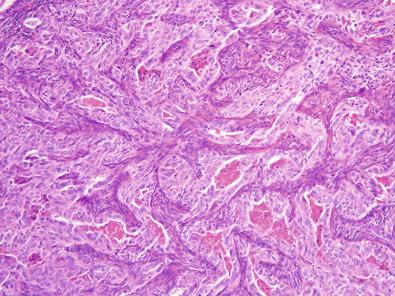
Cytomorphologic features that should be taken into consideration when evaluating epithelioid soft tissue tumors include: (1) the appearance of the nuclei and (2) the quality of the cytoplasm.
Many epithelioid soft tissue neoplasms exhibit vesicular nuclei with a single central prominent nucleolus ( Box 6.10 and Fig. 6.2 ). Conversely, perivascular epithelioid cell tumors (PEComas) and gastrointestinal stromal tumors, for instance, tend to show nuclei with fine chromatin and indistinct nucleoli.
Extrarenal malignant rhabdoid tumor
Epithelioid sarcoma
Epithelioid angiosarcoma
Epithelioid malignant peripheral nerve sheath tumor
Alveolar soft part sarcoma
Rhabdomyosarcoma (epithelioid variant)
Clear cell sarcoma
Epithelioid leiomyosarcoma
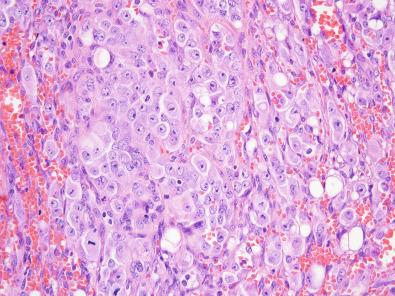
Tumor cell cytoplasm can be copious or minimal and may show an eosinophilic or clear appearance. In some tumor types, the cytoplasm is often vacuolated (e.g., chordoma, epithelioid hemangioendothelioma [EHE], epithelioid angiosarcoma), or may contain rhabdoid inclusions (e.g., malignant rhabdoid tumor (MRT), epithelioid sarcoma, myoepithelioma/myoepithelial carcinoma), or occasionally melanin pigment (e.g., clear cell sarcoma, PEComa).
The distinctive tumor stroma is sometimes very helpful in pointing to a specific diagnosis. The extracellular matrix is usually poorly developed or virtually absent in some tumor types, such as extrarenal MRT or epithelioid malignant peripheral nerve sheath tumor (MPNST). In contrast, some other neoplasms are characterized by a prominent collagenous stroma (e.g., undifferentiated pleomorphic sarcoma, epithelioid sarcoma), myxoid stroma (e.g., extraskeletal myxoid chondrosarcoma (EMC), myoepithelioma, chordoma), or hyalinized to chondromyxoid stroma (e.g., chondroid lipoma, myoepithelioma, EHE).
Immunohistochemistry is required for the evaluation of most epithelioid mesenchymal tumors, not only for tumor typing and subtyping but also to exclude nonmesenchymal tumors, such as metastatic carcinoma, metastatic melanoma, lymphoma, paraganglioma, and malignant mesothelioma.
The immunoprofiles of the most common epithelioid tumors of soft tissue are summarized in Table 6.1 .
| KRT | EMA | S-100 | HMB-45 | SMA | Des | Myog | CD34 | CD31 | INI1 | |
|---|---|---|---|---|---|---|---|---|---|---|
| Carcinoma | + | + | ± | − | − | − | − | − | − | + |
| Melanoma | − | − | + | + | − | − | − | − | − | + |
| Mesothelioma | + | + | − | − | − | ± | − | − | − | + |
| Chordoma | + | + | + | − | − | − | − | − | − | + |
| Myoepithelioma | + | + | + | − | ± | − | − | − | − | ± |
| Synovial sarcoma | + | + | ± | − | − | − | − | − | − | + |
| Epithelioid sarcoma | + | + | − | − | ± | − | − | ± | − | − |
| Clear cell sarcoma | − | − | + | + | − | − | − | − | − | + |
| Alveolar soft part sarcoma | − | − | − | − | − | − | − | − | − | + |
| Extraskeletal myxoid chondrosarcoma | − | − | ± | − | ± | − | − | − | − | + |
| Rhabdomyosarcoma | − | − | ± | − | ± | + | + | − | − | + |
| Epithelioid hemangioendothelioma | ± | − | − | − | ± | − | − | + | + | + |
| Epithelioid angiosarcoma | ± | − | − | − | − | − | − | + | + | + |
| Epithelioid malignant peripheral nerve sheath tumor | − | − | + | − | − | − | − | − | − | ± |
| Desmoplastic small round cell tumor | + | + | ± | − | − | + | − | − | − | + |
| Malignant rhabdoid tumor | + | + | ± | − | ± | − | − | − | − | − |
Some sarcomas that show an epithelioid appearance bear specific translocations (see also Chapter 18 ), which can be detected with conventional karyotyping, fluorescence in situ hybridization (FISH), or reverse transcriptase-polymerase chain reaction (RT-PCR) ( Table 6.2 ).
| Sarcoma Type | Main Chromosomal or Molecular Abnormalities | Genes Involved |
|---|---|---|
| Synovial sarcoma | t(X;18)(p11;q11) | SS18-SSX1/SSX2 |
| Extraskeletal myxoid chondrosarcoma | t(9;22)(q22;q12) | EWSR1-NR4A3 |
| t(9;17)(q22;q11) | RBP56-NR4A3 | |
| t(9;15)(q22;q21) | TCF12-NR4A3 | |
| Myoepithelial tumors | t(1;22)(q23;q12) | EWSR1-PBX1 |
| t(19;22)(q13;q12) | EWSR1-ZNF444 | |
| t(6;22)(p21;q12) | EWSR1-POU5F1 | |
| Clear cell sarcoma | t(12;22)(q13;q12) | ATF1-EWSR1 |
| t(2;22)(q32.3;q12) | CREB1-EWSR1 | |
| Malignant rhabdoid tumor | Mutations, deletions | SMARCB1 (INI1) |
| Alveolar soft part sarcoma | t(X;17)(p11.2;q25) | ASPSCR1-TFE3 |
| Desmoplastic small round cell tumor | t(11;22)(p13;q12) | WT1-EWSR1 |
| Dedifferentiated liposarcoma | Ring and giant marker chromosomes (amplification of 12q13-15) | MDM2, CDK4 |
| Gastrointestinal stromal tumor | Mutations, deletions | KIT, PDGFRA |
| Sclerosing epithelioid fibrosarcoma | t(11;22)(p11.2;q12.2) | EWSR1-CREB3L1 |
| t(7;22)(q33;q12.2) | EWSR1-CREB3L2 | |
| t(7;16)(q33;p11) | FUS-CREB3L1 | |
| Proximal-type epithelioid sarcoma | Deletions, mutations | SMARCB1 (INI1) |
| Rarely SMARCA4 | ||
| Epithelioid hemangioendothelioma | t(1;3)(p36;q25) | WWTR1-CAMTA1 |
| t(X;11)(p11;q22) | YAP1-TFE3 |
Originally described as angiolymphoid hyperplasia with eosinophilia , epithelioid hemangioma is an unusual benign vascular neoplasm occurring mostly in the skin but also occasionally in deep soft tissue, bone, and viscera. It is unrelated to Kimura disease, with which it has previously been confused. Epithelioid hemangioma is also discussed in Chapter 13 .
Epithelioid hemangioma mostly affects adults 20 to 40 years of age, who are predominantly women. This tumor type has a predilection for the head and neck region, especially around the ear. Lesions are superficial, may be solitary or multiple (20% of cases), and present clinically as small (≤1 cm), sometimes ulcerated, bluish nodules.
Epithelioid hemangioma is a circumscribed lesion of the dermis and subcutis. It is rarely found in deep soft tissue. In this situation, it tends to be larger, shows a more infiltrative growth pattern, and frequently develops around a large vein.
Histologically, epithelioid hemangioma is a lobulated lesion composed of a variable admixture of small capillary-sized vessels, bland epithelioid cells, and inflammatory cells ( Figs. 6.3 and 6.4 ). Small vessels tend to aggregate around a central larger parent vessel, similar to pyogenic granuloma. Endothelial cells that line the vessels have prominent epithelioid cytology and tend to protrude into the lumina in a hobnail fashion, resembling tombstones ( Fig. 6.5 ). The cytoplasm is copious, eosinophilic to amphophilic, and sometimes vacuolated. Nuclei are small and vesicular, often with small central nucleoli. There is no significant cytologic atypia or necrosis, and mitotic figures are scarce. Some epithelioid hemangiomas are densely cellular, and the underlying vascular architecture may be difficult to appreciate ( Figs. 6.6 and 6.7A ). Many epithelioid hemangiomas are associated with a prominent inflammatory component composed predominantly of eosinophils, but also of lymphocytes, mast cells, and plasma cells. Lymphoid aggregates may be observed in long-standing lesions. Occasionally, larger blood vessels with muscular walls showing myxoid change are observed within the lesion. Origin from a muscular artery or a vein is sometimes evident.
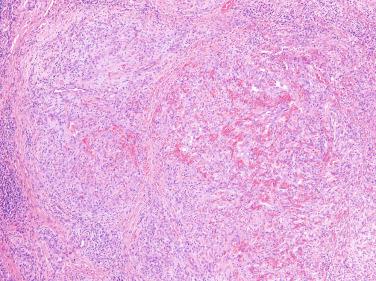
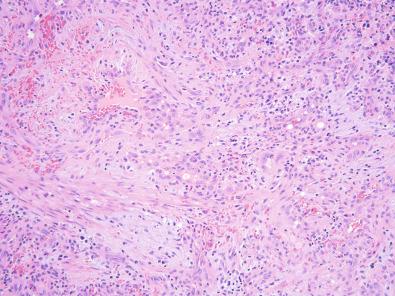
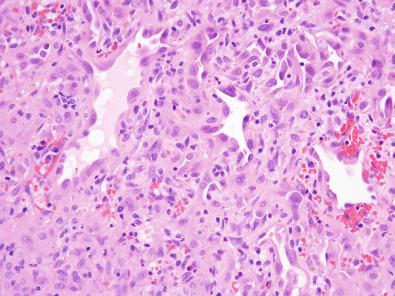
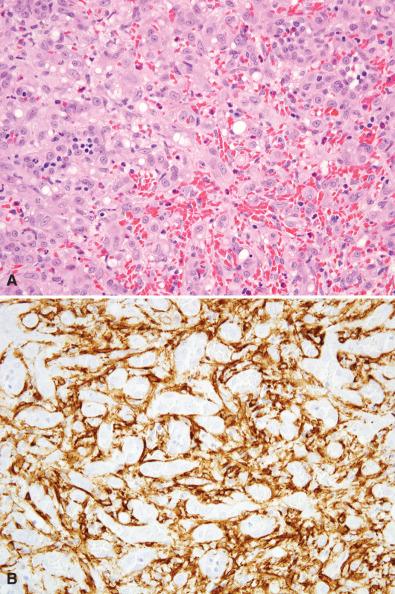
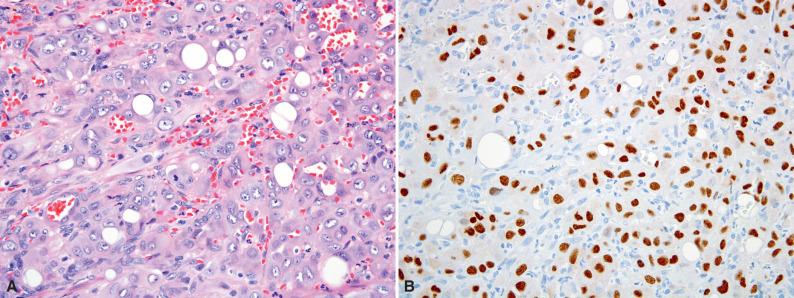
Intravascular epithelioid hemangioma is a rare variant of epithelioid hemangioma in which endothelial cells proliferate within a large vein. This lesion was originally called intravenous atypical vascular proliferation. Epithelioid angiomatous nodule is a benign cutaneous lesion that shows some morphologic overlap with epithelioid hemangioma (see Chapter 13 ). It develops mostly on the trunk (50% of cases) and extremities (30%). Morphologically, it differs from conventional epithelioid hemangioma in that it has a more solid growth pattern, and prominent nucleoli are often seen ( Fig. 6.8 ). At the periphery of the lesion, well-formed blood vessels and hemosiderin deposition may be present. Mitotic activity may be identified. Despite these worrisome features, the behavior is entirely benign.
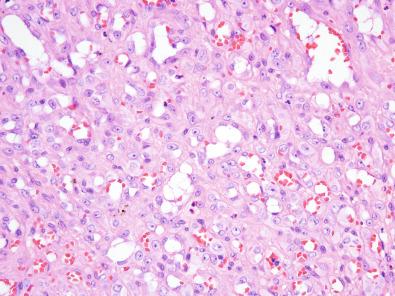
Epithelioid cells in epithelioid hemangioma react with vascular markers, namely CD31, CD34, ERG, and FLI1. CD31 is more sensitive than CD34. On occasion, epithelioid cells may focally express keratins (10% of cases). Overexpression of FOSB is seen in approximately 50% of epithelioid hemangiomas, reflecting the presence of FOSB rearrangements (see Fig. 6.7B ). Reactivity for FOSB is also observed in pseudomyogenic hemangioendothelioma, due to the presence of a SERPINE1-FOSB fusion gene, but not in other epithelioid vascular tumors; therefore, FOSB may be helpful in distinguishing epithelioid hemangioma from EHE.
Recently, FOSB gene rearrangements have been identified in approximately 20% of epithelioid hemangiomas across different anatomic locations and histologic variants; however, the highest prevalence is seen in cellular and intraosseous lesions. Fusion partners identified to date include ZFP36 and LMNA . The recurrent fusion ZFP36-FOSB is seen in cases with increased cellularity, necrosis, and cytologic atypia; these lesions are often penile in location. To date, FOSB gene rearrangements have not been identified in the subset of epithelioid hemangiomas with features of angiolymphoid hyperplasia with eosinophilia, suggesting a distinct pathogenesis for this particular subtype (although immunohistochemistry for FOSB is positive in such lesions). Another 30% of epithelioid hemangiomas harbor FOS gene rearrangements (with a range of fusion partners), most often in soft tissue and bone lesions.
Refer to Box 6.11 for the differential diagnosis of epithelioid hemangioma.
Bacillary angiomatosis
Epithelioid fibrous histiocytoma
Epithelioid schwannoma
Epithelioid hemangioendothelioma
Epithelioid angiosarcoma
Myoepithelioma
Carcinoma
Melanoma
Bacillary angiomatosis is composed of epithelioid cells and blood vessels, bearing some resemblance to pyogenic granuloma. The lesion contains numerous neutrophils and easily overlooked clusters of bacteria.
EHE is larger and more atypical cytologically than epithelioid hemangioma. Capillary-sized vessels and a prominent inflammatory infiltrate are not features of EHE. In contrast to epithelioid hemangioma, tumor cells in EHE are arranged in cords and nests and are characteristically set in a distinctive chondroid-to-myxohyaline matrix. Around 90% of EHE cases show nuclear expression of CAMTA1, due to the presence of the WWTR1-CAMTA1 fusion gene; CAMTA1 expression is not seen in epithelioid hemangioma.
Solid forms of epithelioid hemangioma may be confused with epithelioid angiosarcoma, epithelioid sarcoma, and myoepithelioma with plasmacytoid (hyaline cell) features. Epithelioid angiosarcoma is composed of large epithelioid cells with prominent nucleoli. The presence of marked nuclear atypia and sheetlike growth distinguishes epithelioid angiosarcoma from epithelioid hemangioma. Foci of necrosis and a high mitotic rate are common in epithelioid angiosarcoma.
Epithelioid sarcoma is composed of epithelioid and occasionally spindle cells in varying proportions. In contrast to epithelioid hemangioma, epithelioid sarcoma is often necrotic and infiltrative. In addition, tumor cells in epithelioid sarcoma are usually diffusely positive for keratins and epithelial membrane antigen (EMA). They can express CD34 but not CD31. Loss of INI1 (SMARCB1) expression is helpful to confirm the diagnosis of epithelioid sarcoma.
Myoepithelioma with hyaline cell (plasmacytoid) features may mimic epithelioid hemangioma. This lesion, however, expresses epithelial markers, S-100 protein, and often SOX10 and is negative for CD31 and CD34.
Kimura disease has been confused with epithelioid hemangioma, although these lesions are histologically dissimilar and unrelated. Kimura disease affects mainly young Asian men and presents as a combination of a soft tissue mass, lymphadenopathy, systemic eosinophilia, elevated serum immunoglobulin E, and various other immunologic disorders. This lesion, which often involves the skin and deep soft tissues of the head and neck region, is a pseudotumor composed of an admixture of dense lymphoid aggregates with prominent germinal centers, an eosinophilic infiltrate including eosinophilic microabscesses, small blood vessels, and fibrosis. As opposed to epithelioid hemangioma, there are no vessels lined by epithelioid endothelial cells in Kimura disease.
Epithelioid hemangioma may recur locally (in 30% of cases) but does not metastasize. Complete surgical excision is the treatment of choice.
Accounting for approximately 0.5% to 1.5% of soft tissue tumors, glomus tumors may present in two different forms: a sporadic form, where the lesion is usually solitary, and a familial form, which tends to occur in children as multifocal lesions associated with dilated veins ( glomuvenous malformation ; see Chapter 13 ).
In the sporadic form, glomus tumors present as solitary lesions of the distal extremities of middle-aged adults. There is a female predominance (female-to-male ratio, 3 : 1) in patients with subungual lesions. Glomus tumors are often exquisitely painful and are sensitive to cold and tactile stimuli. They are usually found in subungual locations, although they can also be observed in the deep dermis or subcutis of the hands, wrists, forearms, and feet. Glomus tumors are rare in deep soft tissues. Rarely, they are observed at other sites, such as the nasal cavity, trachea, stomach, and bone.
In the familial form, glomus tumors and glomangiomas (also known as glomuvenous malformations ) are multifocal and may be diffusely infiltrative (glomangiomatosis); such lesions occur predominantly in children. These tumors are sometimes painful and rarely subungual. They can be congenital and are usually seen in the superficial soft tissues of the arms and legs.
Glomus tumors often develop as small blue-red nodules measuring less than 1 cm when superficially located. Histologically, they are composed of a variable admixture of three components: small, rounded, uniform epithelioid cells, often with punched-out nuclei and sharply defined cytoplasmic borders; small, capillary-sized vessels, surrounded by the glomus cells; and smooth muscle bundles sometimes associated with thick-walled blood vessels ( Fig. 6.9 ). Hyaline or myxoid stroma is relatively common ( Fig. 6.10 ). Cytologic atypia and mitotic activity are not observed in benign glomus tumors.
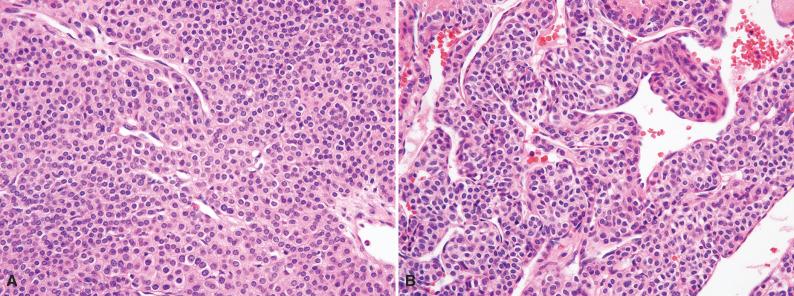
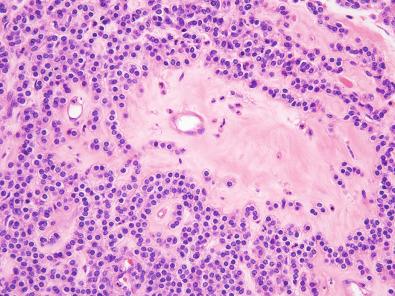
Some variants of glomus tumor with unusual histologic features are recognized. Epithelioid (oncocytic) glomus tumor is a variant characterized by large polygonal epithelioid cells with abundant eosinophilic cytoplasm and large nuclei, sometimes admixed with spindle cell areas ( Fig. 6.11 ).
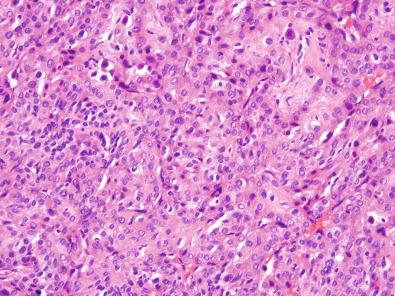
Symplastic glomus tumor shows degenerative nuclear atypia (analogous to symplastic leiomyoma).
The rare malignant glomus tumors may be composed of sheets of round cells with marked nuclear atypia and mitotic activity (see “Prognosis and Treatment”) or fascicles of atypical spindle cells, sometimes mimicking leiomyosarcoma; the latter group of tumors is difficult to recognize unless there is a conventional glomus tumor component.
Glomangioma is a lesion characterized by dilated cavernous venous structures (resembling those of a cavernous hemangioma), surrounded by a thin rim of glomus cells (also known as glomuvenous malformation ) ( Fig. 6.12 ). This form is predominantly observed in familial glomus tumors.
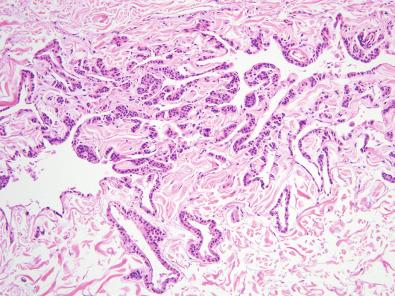
Glomangiomyoma has morphologic features identical to those of conventional glomus tumor or glomangioma, in addition to the presence of well-developed smooth muscle and large vessel components ( Fig. 6.13 ). The elongated smooth muscle cells appear to arise from large vessel walls and may show a gradual transition to conventional small round glomus cells.
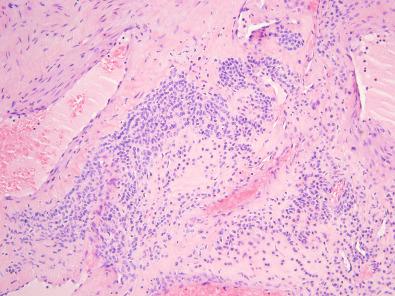
Glomangiopericytoma (also called myopericytoma or perivascular myoma ) shares features of conventional glomus tumor, glomangiomyoma, and vascular leiomyoma (angioleiomyoma) ( Fig. 6.14 ). It belongs to the spectrum of lesions showing perivascular myoid differentiation along with myofibroma. Glomangiopericytoma occurs predominantly in the superficial soft tissues of the distal extremities, often the wrist and ankle (see Chapter 3 ).
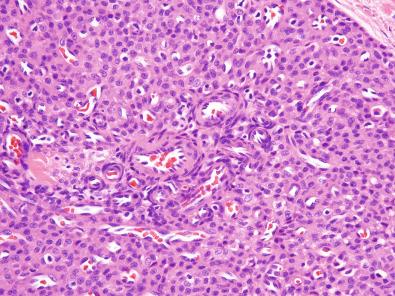
Glomus coccygeum corresponds to a prominent or hyperplastic glomus structure located at the ventral tip of the coccyx. Rarely, a true glomus tumor may develop from this structure.
Glomus cells show strong reactivity for smooth muscle actin ( Fig. 6.15 ), muscle-specific actin, and h-caldesmon. Desmin is occasionally positive (up to 20% of cases), usually only focally. Glomus cells can also be focally CD34 positive. S-100 protein, CD31, and epithelial markers are negative. Tumor cells are surrounded by pericellular basement membrane material, which can be visualized with antibodies against collagen IV and laminin, although these are rarely used for diagnosis.
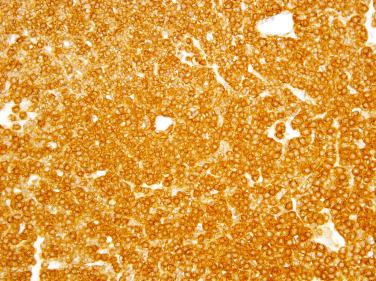
NOTCH gene rearrangements occur in approximately 60% of glomus tumors. NOTCH2 rearrangements predominate and are identified in most malignant glomus tumors, whereas NOTCH1 and NOTCH3 rearrangements are found in a small subset of predominantly benign glomus tumors. MIR143 has been identified as a fusion partner with NOTCH in some cases. BRAF V600E and KRAS mutations have been reported in a few glomus tumor cases.
A cellular, epithelioid glomus tumor may occasionally be confused with a solid variant of nodular hidradenoma ( Fig. 6.16 ). In contrast to a glomus tumor, nodular hidradenoma is positive for keratins, EMA, and carcinoembryonic antigen.
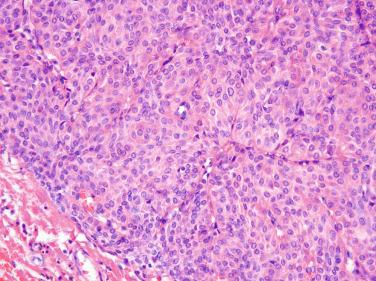
Unlike glomus tumors, intradermal melanocytic nevus (including the pseudovascular variant) is composed of S-100 protein–positive cells.
A carcinoma can be excluded based on clinical findings, reactivity for keratin and EMA, and negativity for smooth muscle actin.
Conventional cavernous hemangioma may superficially resemble glomangioma. However, unlike conventional cavernous hemangioma, glomangioma shows a thin rim of glomus cells situated around the vascular spaces.
Glomus tumors showing a well-developed smooth muscle component or prominent hemangiopericytoma-like features may be confused with myofibroma, infantile myofibromatosis, or myopericytoma. This distinction is of little importance, however, because these entities are related, benign lesions that lie on a morphologic continuum ( Box 6.12 ).
Adnexal tumor (hidradenoma [solid form], eccrine spiradenoma)
Carcinoma (metastasis)
Meningioma (cutaneous)
Intradermal nevus (pseudovascular nevus)
Epithelioid leiomyoma
Cavernous hemangioma
Myofibroma/myofibromatosis
Leiomyoma and vascular leiomyoma (angioleiomyoma)
Glomus tumors may recur locally (10% of cases, especially infiltrative lesions). Malignant glomus tumors are exceptional and include (1) glomus tumors showing marked nuclear atypia along with any mitotic activity and (2) those containing atypical mitotic figures. In a study by Folpe and colleagues, metastases developed in 38% of patients with malignant glomus tumors (defined by these criteria).
Glomus tumors of “uncertain malignant potential” have been defined as superficial lesions lacking nuclear atypia but containing numerous mitoses (>5 per 50 high-power fields), large (>2 cm) glomus tumors, and deep-seated glomus tumors. Glomus tumors with these features usually behave in a benign fashion.
Well known in salivary glands, mixed tumors (pleomorphic adenomas), myoepitheliomas, and myoepithelial carcinomas can also arise primarily in soft tissue and bone. Chondroid syringoma, a mixed tumor of the skin, has been incorporated into the spectrum of cutaneous neoplasms that show myoepithelial differentiation (see Chapter 15 ). Parachordoma, a rare soft tissue tumor described by Dabska in 1977, is a morphologic variant of soft tissue myoepithelioma. Myoepithelial neoplasms of soft tissue range from benign to aggressive malignant tumors. Several criteria have been proposed to assess their malignant potential (see the discussion of prognosis). Myoepithelial tumors are also discussed in Chapters 5 and 9 .
Myoepitheliomas of soft tissue develop predominantly in the limbs (65% of cases) and limb girdles (shoulder, thigh, inguinal region) of middle-aged adults (median age, 40 to 50 years), with a slight male predominance (male-to-female ratio, 1.3 : 1). The trunk, head and neck, and visceral soft tissue are less frequently involved. Myoepithelial tumors are most often located in the subcutis (60%); a minority arise in deep soft tissue (intramuscular or subfascial). Most patients present with a painless mass.
Grossly, most myoepithelial neoplasms of soft tissue are well circumscribed and nodular, although a subset of tumors show infiltrative borders or satellite nodules. The mean size of benign tumors is 4 cm, compared with 6 cm for malignant lesions, with a wide range in size (1 to 20 cm). Gelatinous/myxoid areas are common. Areas of calcification or ossification may be seen. Necrosis is rare.
Histologically, myoepithelial tumors of soft tissue are heterogeneous, paralleling mixed tumors of salivary glands. Characteristically, they show a lobulated architecture ( Fig. 6.17 ), and are composed of a variable admixture of cords, strands, and nests of epithelioid to spindled cells, set in a hyalinized to chondromyxoid matrix ( Fig. 6.18 ; see also Fig. 6.17 ). Some tumors are composed predominantly of spindle cells, whereas others are epithelioid in appearance. Epithelioid myoepithelial cells may be large, with abundant clear to eosinophilic cytoplasm ( Figs. 6.19 and 6.20 ). Occasionally, tumor cells may have a plasmacytoid appearance, with prominent hyaline cytoplasmic inclusions ( Fig. 6.21 ). Metaplastic cartilage or bone is detected in 10% to 15% of cases. Approximately 10% of myoepitheliomas show ductal differentiation; such tumors can alternatively be referred to as mixed tumors of soft tissue (see also Chapter 9 ). An adipocytic component, squamous differentiation, osteoclastic giant cells, amianthoid collagen fibers, and tyrosine crystals are additional uncommon morphologic features.
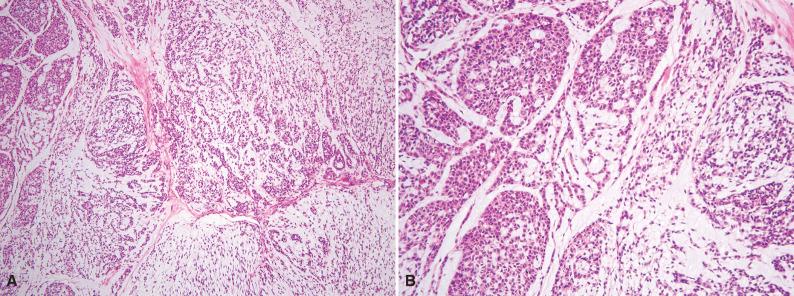
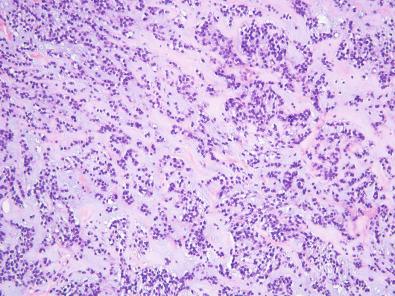
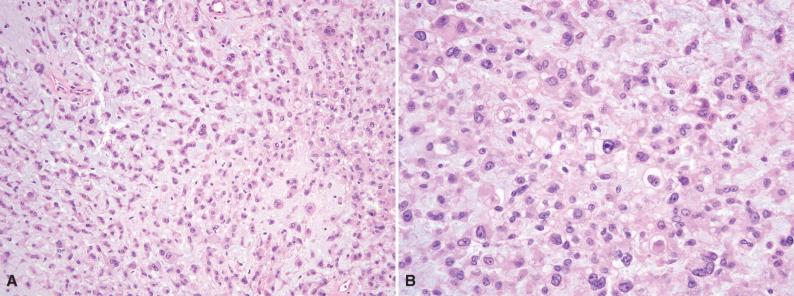
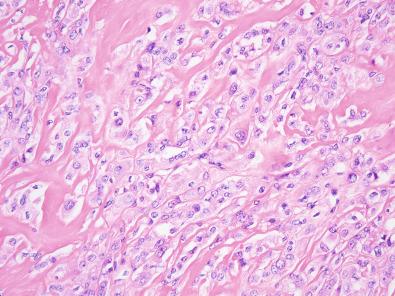
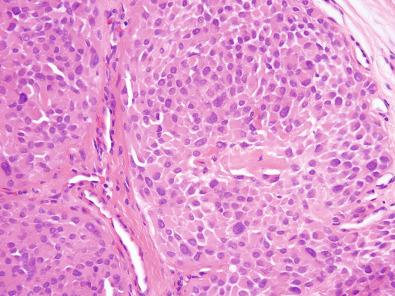
Myoepithelial carcinomas of soft tissue are usually larger than benign lesions and show a variable degree of nuclear atypia (see Figs. 6.19 and 6.20 ), along with mitotic activity and tumor necrosis (40% of cases; see “Prognosis and Treatment”). Myoepithelial carcinomas may contain an undifferentiated round cell component, particularly in children. In a small number of cases, a malignant heterologous mesenchymal component (osteosarcoma or chondrosarcoma) may be present ( malignant mixed tumor ). Unlike myoepithelial carcinomas of the salivary glands, a benign precursor lesion is rarely identified in myoepithelial carcinomas of soft tissue.
By immunohistochemistry, tumor cells of myoepitheliomas of soft tissue usually express epithelial markers, such as broad-spectrum keratins (90% to 95% of cases), EMA (60%), and S-100 protein (80% to 90%) ( Fig. 6.22 ). Calponin (80% to 90%), glial fibrillary acidic protein (GFAP) (40% to 50%), smooth muscle actin (35% to 40%), and desmin (10% to 15%) can also be expressed. p63 is positive in 20% to 40% of cases. SOX10 is positive in most soft tissue myoepitheliomas, but less often in myoepithelial carcinomas. A subset of myoepithelial carcinomas of soft tissue shows loss of expression of INI1 (SMARCB1), most often in pediatric cases (up to 40%).
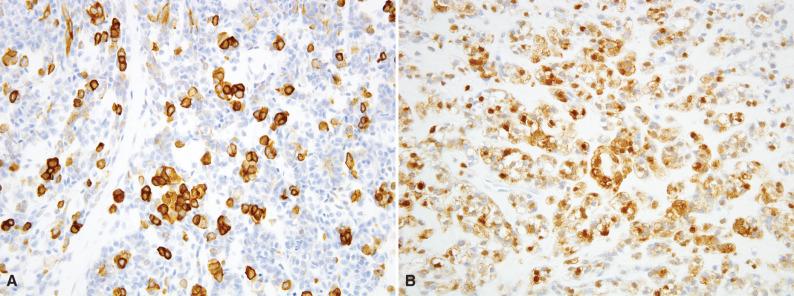
The genetic profile of soft tissue myoepitheliomas appears heterogeneous. Rearrangements of the EWSR1 gene have been detected in approximately 50% of myoepithelial tumors of skin and soft tissue, involving diverse fusion partners : POU5F1 (6p21), PBX1 (1q23), ZNF444 (19q23), ATF1 (12q13), PBX3 (9q33), and KLF17 (1p34); these genes only account for a subset of tumors with EWSR1 rearrangement. A subset of myoepithelial tumors that lack EWSR1 rearrangement instead have alternative FUS rearrangement. Similar to their salivary gland counterparts, mixed tumors of skin and soft tissue often harbor PLAG1 rearrangements. EWSR1 and PLAG1 rearrangements are mutually exclusive.
In deep soft tissues, myoepithelioma should be differentiated primarily from EMC, metastatic chordoma, ossifying fibromyxoid tumor (OFMT), epithelioid schwannoma, and chondroid lipoma. Tumors predominantly composed of myoepithelial cells that display a plasmacytoid or rhabdoid appearance may be confused with metastatic carcinoma, metastatic melanoma, or sarcomas with epithelioid morphology (e.g., epithelioid sarcoma, epithelioid MPNST, EHE, or epithelioid angiosarcoma) ( Box 6.13 ).
Extraskeletal myxoid chondrosarcoma
Ossifying fibromyxoid tumor
Epithelioid schwannoma
Chondroid lipoma
Chondroma of soft tissue
Chordoma
Epithelioid sarcoma
Epithelioid hemangioendothelioma and angiosarcoma
Epithelioid malignant peripheral nerve sheath tumor
Carcinoma (metastasis)
Melanoma (metastasis)
EMC is a lobulated neoplasm composed of cords and strands of small epithelioid cells in an abundant myxoid matrix. Tumor cells, which are arranged in a reticular or sometimes pseudoacinar pattern ( Fig. 6.23A ) and tend to accumulate at the periphery of tumor lobules, can be epithelioid or rhabdoid, particularly in high-grade cases (see Fig. 6.23B ). By immunohistochemistry, a subset of EMCs express S-100 protein (20% of cases) less consistently than myoepithelioma, and S-100 protein expression is usually only focal. Most EMCs are negative for epithelial markers, although occasional cases can show scattered cells positive for EMA and smooth muscle actin or GFAP. EMC bears specific reciprocal translocations, most commonly the t(9;22)(q22;q12) translocation involving NR4A3 and EWSR1 , less often t(9;17)(q22;q11) involving NR4A3 and TAF2N , and rarely other translocations involving NR4A3 , chromosomal abnormalities that are not observed in myoepithelioma. However, because some myoepithelial tumors harbor EWSR1 rearrangements, FISH for EWSR1 cannot distinguish between these tumor types.
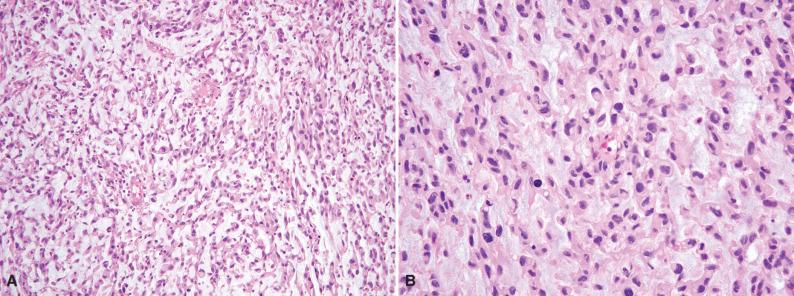
Metastatic chordoma may closely resemble soft tissue myoepitheliomas, with epithelioid cells that have abundant cytoplasm ( Fig. 6.24 ) and usually express epithelial markers and S-100 protein. However, chordomas are uniform, whereas myoepithelial tumors characteristically show considerable intratumoral heterogeneity with reticular and solid areas as well as mixed epithelioid and spindle cell components. Chordomas are consistently positive for brachyury. Very rarely, chordoma can arise primarily at extraaxial sites, exceptionally in soft tissue (“chordoma periphericum”). Such tumors are indistinguishable from metastatic chordoma; the clinical history is therefore essential.
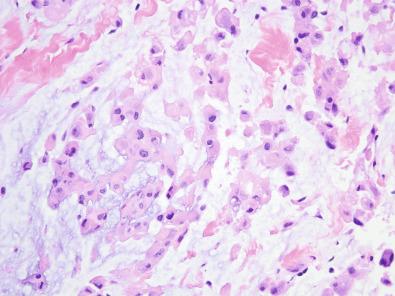
In OFMT, the tumor cells are uniform and bland, with round to ovoid nuclei, arranged in cords within a variably fibromyxoid matrix. Most lesions (80%) are surrounded by a characteristic rim of mature lamellar bone. Tumor cells in OFMT usually express S-100 protein (70% of cases), and in 50% of cases desmin is positive. Occasionally, GFAP and smooth muscle actin may be focally positive. In contrast to myoepithelioma, OFMT is generally negative for keratins and EMA.
Epithelioid schwannoma is a well-circumscribed lobulated neoplasm, composed of nests and trabeculae of bland, small, rounded Schwann cells with abundant eosinophilic cytoplasm. The extracellular matrix may be myxoid or fibrillary. Tumor cells are strikingly positive for S-100 protein but negative for epithelial markers, in contrast to myoepitheliomas.
Chondroid lipoma is a benign adipocytic neoplasm that typically presents as a painless nodule in the subcutis or skeletal muscle of middle-aged adults, mostly women. It usually involves the proximal extremities or limb girdles. Histologically, chondroid lipoma shows a lobulated growth pattern and is composed of a variable admixture of large uni- or multivacuolated lipoblast-like cells, cords and strands of finely vacuolated cells resembling hibernoma cells or chondroblasts, and mature adipocytes, set in a myxoid to hyalinized or chondroid matrix ( Fig. 6.25 ). Tumor cells in chondroid lipoma are consistently immunoreactive for S-100 protein but negative for smooth muscle actin and EMA. Occasionally, keratins may be focally positive.
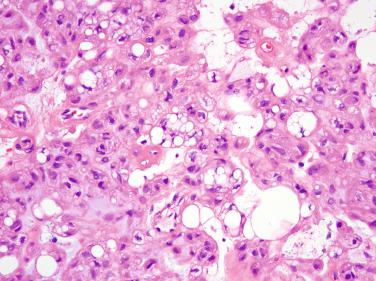
Myoepitheliomas showing prominent cartilaginous differentiation should be differentiated from soft tissue chondroma, which is composed solely of cartilaginous cells that are negative for epithelial markers.
Solid spindle cell myoepitheliomas may be confused with schwannomas or smooth muscle tumors of deep soft tissue.
Myoepithelial carcinomas of soft tissue should be differentiated primarily from epithelioid MPNST, high-grade EMC, sclerosing epithelioid fibrosarcoma (SEF), proximal-type epithelioid sarcoma, metastatic carcinoma, and metastatic melanoma (see Chapter 5 ).
Myoepithelial tumors of soft tissue have the potential to recur and metastasize. Unlike myoepithelial tumors of salivary glands, infiltrative margins do not correlate with malignancy in myoepithelial neoplasms of soft tissue. Myoepithelial tumors with moderate or severe nuclear atypia in the form of nuclear pleomorphism, vesicular or coarse chromatin, and prominent nucleoli should be classified as myoepithelial carcinomas. Mitotic activity and tumor necrosis do not correlate with outcome.
Soft tissue myoepithelial carcinomas have a 35% to 40% local recurrence rate and a 30% to 40% metastatic rate. The most common metastatic sites are the lungs, lymph nodes, bone, and soft tissue. Myoepithelial carcinomas of deep soft tissue and those at visceral sites have a worse prognosis than superficial lesions. Myoepithelial tumors of soft tissue in children are much more likely to be malignant than those in adults. Cytologically benign or low-grade lesions (myoepitheliomas) may recur locally (15% to 20% of cases), but do not metastasize, with rare exceptions. All myoepithelial neoplasms should be completely excised with negative margins. The role of adjuvant chemotherapy or radiation therapy remains to be determined, although combination chemotherapy with carboplatin and paclitaxel shows promise for patients with metastatic disease.
The concept of neoplasms with perivascular epithelioid cell (PEC) differentiation was developed in 1992 by Bonetti and colleagues. These authors observed that a group of neoplasms found at various locations were composed of cells that seemed to originate from the walls of blood vessels and showed distinctive morphologic, immunohistochemical, and ultrastructural characteristics, namely, features of both smooth muscle and melanocytic differentiation. They proposed the descriptive term PEC to describe these cells and proposed grouping the neoplasms composed of these cells under the term PEComa . Gradually, this family of tumors gained wide acceptance and now includes renal and extrarenal angiomyolipoma (AML), lymphangio(leio)myoma and lymphangio(leio)myomatosis (LAM), clear cell (“sugar”) tumor (CCST) of the lungs and extrapulmonary sites, clear cell myomelanocytic tumor of the falciform ligament/ligamentum teres, and abdominopelvic sarcoma of PECs. An association between the tuberous sclerosis complex (TSC) and some PEC neoplasms (e.g., AML, LAM) has also been recognized. PEComas are now increasingly recognized at diverse anatomic locations, including soft tissues, skin, bone, and visceral organs. Monotypic epithelioid AML, extrapulmonary “sugar” tumor, and PEC tumor are all synonyms for the term PEComa. In this section, only renal AMLs and PEComas of soft tissue showing predominantly epithelioid features are specifically discussed. Pulmonary and extrapulmonary LAMs, which are usually composed predominantly of spindle cells, are not discussed in this chapter (see Chapter 3 ).
PEComas are rare neoplasms, occurring mostly in women. In addition to the kidney (renal AML), the lungs (CCST and LAM), and the liver (epithelioid AML), rare cases have been described at diverse anatomic sites, such as the retroperitoneum, uterus, vulva, falciform ligament/ligamentum teres, large and small bowel, pancreas, mesentery, omentum, pelvis, heart, and bone. Clinical features depend mainly on the size and location of the neoplasm. The term PEComa not otherwise specified (PEComa NOS), or simply PEComa , refers to all PEComas other than AML and LAM.
AML occurs most commonly in middle-aged patients (median age, 40 to 50 years), with a female predominance (female-to-male ratio, 4 : 1 for sporadic AML, whereas this sex predilection is not found in AML associated with TSC). Fewer than half of cases are associated with TSC. This lesion, which has long been considered a hamartoma, is now recognized as a clonal mesenchymal neoplasm. The most common presenting symptoms include pain, hematuria, and fever. AML may also present as an incidental finding on computed tomography scan, at the time of surgery, or at autopsy. Rarely, tumor rupture leads to massive, life-threatening retroperitoneal hemorrhage. Most cases of AML develop in the kidneys, but some are occasionally found at extrarenal sites, such as the retroperitoneum, pelvis, liver, oral cavity, or lungs. Some retroperitoneal tumors are attached to the kidney by a small pedicle. The radiologic (computed tomography and magnetic resonance imaging scans) appearance is characteristic, allowing preoperative diagnosis in many cases. Outside of TSC, AML usually presents as a solitary mass, measuring 1 to 20 cm (median, 9 cm). Patients with TSC usually have AMLs in both kidneys; these tumors are often multiple, of varying size (often small), and asymptomatic.
PEComas other than AML and LAM are rare neoplasms that have been described under different names, including primary extrapulmonary “sugar” tumor, clear cell myomelanocytic tumor, and abdominopelvic sarcoma of PECs. PEComas tend to occur in middle-aged patients, mostly women (female-to-male ratio, 7 : 1). Up to 40% of these tumors occur in the gynecologic tract, mostly in the uterus but also in the vagina and vulva. An additional 40% are found in the retroperitoneum, soft tissues, and skin, with the remaining cases found mainly in the gastrointestinal tract. However, nearly any anatomic site may be involved. Presenting symptoms depend on the location and size of the tumor.
Grossly, AMLs present as a yellow to gray unencapsulated mass, but the color varies according to the proportions of each component: adipocytes, smooth muscle, and blood vessels. In some cases, especially in the retroperitoneum, the neoplasm may show infiltrative margins and may contain hemorrhagic or necrotic areas. Some tumors may extend into the renal vein and inferior vena cava. AMLs may also involve regional lymph nodes and, more rarely, the spleen; these foci should not be misinterpreted as metastatic deposits of a sarcoma.
Histologically, although a conventional AML is typically composed of mature fat, thick-walled blood vessels, and smooth muscle in varying proportions, an epithelioid AML is composed predominantly or exclusively of epithelioid cells. Pure epithelioid (“monotypic”) AMLs are identical to (and synonymous with) PEComa (discussed later). Tumor cells are large and polygonal, with abundant palely eosinophilic granular to clear cytoplasm ( Fig. 6.26 ). Blood vessels and a mature adipocytic component are focal or absent. When present, blood vessels are usually muscular and thick walled, with hyalinization of the media. Epithelioid cells are less frequently arranged around blood vessels than in conventional AMLs. Nests of tumor cells are often surrounded by delicate capillary vessels ( Fig. 6.27 ), similar to renal cell carcinoma. Nuclear atypia is common, and multinucleated tumor giant cells may be seen. Areas of hemorrhage or tumor necrosis may also be observed. Mitotic activity is usually minimal, except in frankly malignant cases (discussed later).
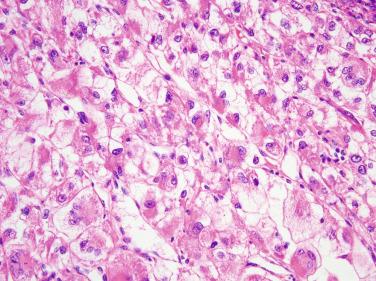
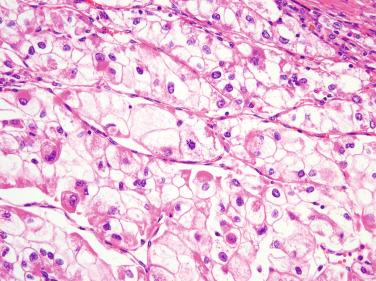
The morphologic features of PEComa are broad. Many of these neoplasms are indistinguishable from epithelioid (monotypic) AML. They are predominantly or exclusively composed of large polygonal epithelioid cells, with abundant granular eosinophilic to clear cytoplasm ( Fig. 6.28 ), often arranged in nests surrounded by delicate capillary vessels. The tumor cells often show focal association with the walls of blood vessels ( Fig. 6.29 ). Some tumors contain multinucleated giant cells ( Fig. 6.30 ). In other cases, the tumor cells are more spindled, with clear cytoplasm, resembling CCST of the lung ( Fig. 6.31 ). Clear cell morphologic features often predominate in tumors of the falciform ligament/ligamentum teres and cutaneous PEComas. A distinctive subset of PEComas (most arising in the retroperitoneum) shows marked stromal hyalinization and a trabecular architecture (“sclerosing PEComa”) ( Fig. 6.32 ). PEComas of the uterus may be difficult to distinguish from epithelioid smooth muscle neoplasms (discussed later). Occasionally, PEComas contain melanin pigment.
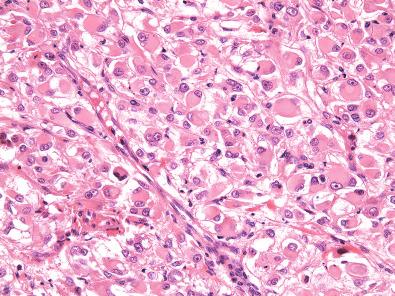
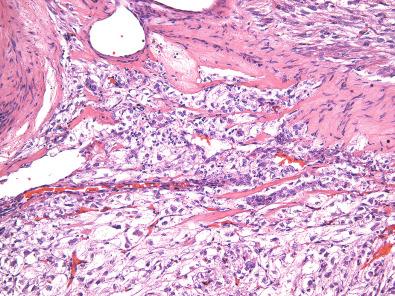
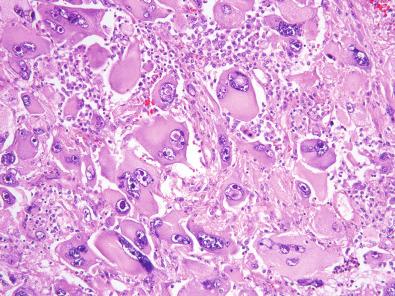
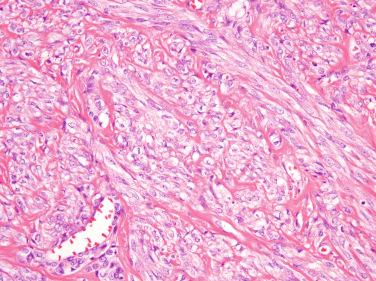
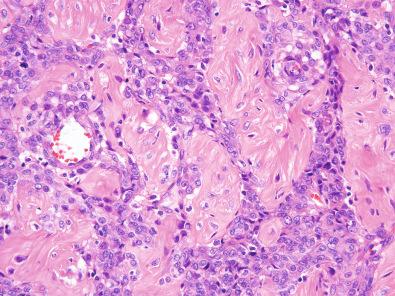
PEComas are characteristically reactive for both smooth muscle markers, most often smooth muscle actin (in ~80% of cases), and melanocytic markers, most often HMB-45 (in ~90% of cases) ( Fig. 6.33 ), but also melan A (~70%) and microphthalmia transcription factor (MITF). The cytoplasmic positivity for HMB-45 is typically finely granular. Approximately 80% of cases coexpress smooth muscle actin and HMB-45 or melan A. Predominantly epithelioid tumors tend to express melanocytic markers more strongly than myogenic markers, whereas the opposite is seen in predominantly spindled PEComas. Desmin (~30%) and S-100 protein (10%) are less often expressed. Occasional PEComas (especially those with clear-cell features) express melanocytic markers without smooth muscle actin (SMA) and desmin. Keratins, EMA, KIT, and CD34 are rarely expressed. Estrogen and progesterone receptors are frequently expressed in AML but less often in other PEComas. Approximately 20% of PEComas show nuclear staining for TFE3, many of which harbor TFE3 gene rearrangements. Cathepsin K has been reported to be a useful marker for PEComa, but in our experience it is relatively nonspecific; expression is also seen in many other mesenchymal tumor types.
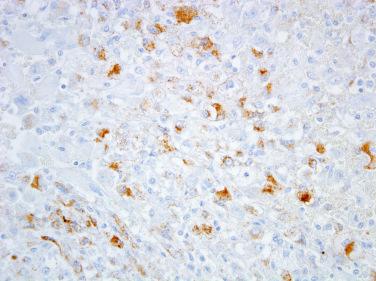
PEComas, including AMLs, LAM, and CCSTs, often bear genetic alterations of the TSC genes. TSC is a genetic disorder caused by mutations of the TSC1 (9q34) or TSC2 (16p13.3) gene (reviewed in references and ). Manifestations of TSC include intellectual disability, seizures, renal cysts, AML, LAM, subependymal giant cell astrocytoma, hyperpigmented spots, periungual fibromas, cutaneous angiofibromas, cardiac rhabdomyoma, gliosis, and calcification of the cerebral cortex. TSC genes play an important role in the regulation of the mammalian target of rapamycin (mTOR) pathway, and this signaling pathway has been found to be deregulated (leading to mTORC1 hyperactivation) in a subset of renal AMLs and extrarenal PEComas. Between 30% and 50% of AMLs occur in patients with TSC, and approximately half of patients with TSC have multiple AMLs. Mutations in TSC1 and TSC2 genes, with loss of expression of the protein products hamartin and tuberin, respectively, have been documented in AMLs. The prevalence of LAM in women with TSC is approximately 35%. In the context of TSC, LAM sometimes occurs in association with multiple AMLs (approximately 25% of patients with LAM have AMLs). Although less than 10% of patients with non-AML, non-LAM PEComa show signs of TSC, deletions of 16p (bearing the TSC2 gene) or allelic losses of TSC2 are the most common genetic changes in both TSC-associated and sporadic PEComas, and lead to activation of the mTOR pathway. In addition, TP53 mutations are also present in most malignant PEComas with TSC2 mutations. The most common alternative pathway of tumorigenesis in PEComa involves TFE3 alterations. Approximately 20% of PEComas (of soft tissue or visceral sites) harbor TFE3 gene rearrangements, which often correlates with a nested or pseudoalveolar growth pattern and overexpression of the TFE3 protein. Fusions involving RAD51L1 ( RAD51B ) with either RRAGB or OPHN1 have been described in a small subset of uterine PEComas.
Become a Clinical Tree membership for Full access and enjoy Unlimited articles
If you are a member. Log in here